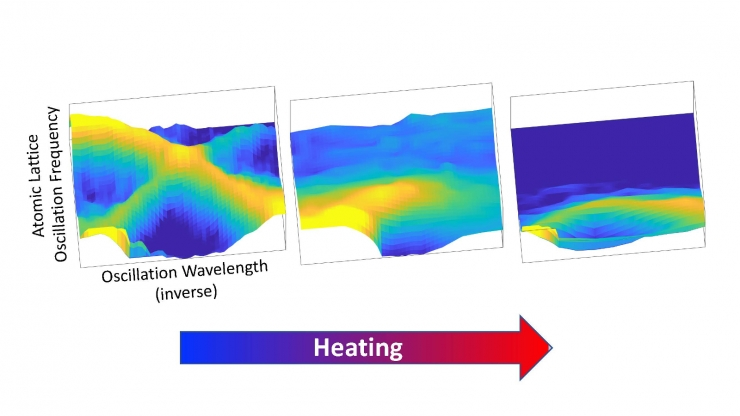Sep 7 2020
An atomic mechanism unraveled by materials scientists from Duke University ensures that specific thermoelectric materials are extremely efficient close to high-temperature phase transitions.
 Evolution of atomic lattice oscillation waves upon heating the tin sulfide crystal, as measured with neutron scattering. Image Credit: Tyson Lanigan-Atkins, Delaire group, Duke University.
Evolution of atomic lattice oscillation waves upon heating the tin sulfide crystal, as measured with neutron scattering. Image Credit: Tyson Lanigan-Atkins, Delaire group, Duke University.
This data will help scientists fill the crucial knowledge gaps that exist in the computational modeling of thermoelectric materials, possibly enabling them to identify new and more improved options for technologies that depend on converting heat into electricity.
The results of the study appeared online in the Nature Communications journal on September 4th, 2020.
In thermoelectric materials, the movement of electrons from the hot side to the cold side normally changes heat into electricity. Since there is a need to provide a temperature variation between the two sides of the material, scientists are keen to recover the energy lost as heat in power plants, or to apply these materials to produce electricity from the heat of the tailpipe of a car.
In the last two years, an emerging material known as tin selenide as well as its sister compound called tin sulfide helped set new records for thermoelectric efficiency. While the sulfide version is not fairly as good as the thermoelectric version, it is being improved further because it is more cost-effective and eco-friendly to create.
While investigators already know that these two compounds are exceptional thermoelectric materials, they are unaware of the exact reason behind this. In the latest analysis, Olivier Delaire, an associate professor of mechanical engineering and materials science from Duke University, and a couple of his graduate students, Tyson Lanigan-Atkins and Shan Yang, attempted to close that knowledge gap slightly.
We wanted to try to understand why these materials have such low thermal conductivity, which helps enable the strong thermoelectric properties they’re known for. Using a powerful combination of neutron scattering measurements and computer simulations, we discovered that it’s related to the material’s atomic vibrations at high temperature, which nobody had seen before.
Olivier Delaire, Associate Professor of Mechanical Engineering and Materials Science, Duke University
Low thermal conductivity is known to be an essential ingredient of any excellent thermoelectric material. But a heat differential between the two sides of this material is generally needed to produce electricity. Therefore, it makes sense to assume that materials that prevent heat from spreading over them would perform quite well.
Delaire and Lanigan-Atkins subsequently took samples to the High Flux Isotope Reactor at the Oak Ridge National Laboratory to visualize the ongoing atomic vibrations of the tin sulfide. When the researchers ricocheted neutrons off of the tin sulfide’s atoms and identified where they end up ultimately, they were able to establish the location of the atoms and how they were jointly vibrating in the lattice of the crystal.
At the Oak Ridge National Laboratory, the facilities were specifically suitable for the job at hand. Since the atomic vibrations of tin sulfide are comparatively slow, the team required low-energy “cold” neutrons that are sufficiently fragile to visualize them. And the Oak Ridge National Laboratory has some of the world’s best cold-neutron instruments.
We found that the tin sulfide effectively has certain modes of vibration that are very ‘floppy. And that its properties are connected with inherent instability in its crystal lattice.
Olivier Delaire, Associate Professor of Mechanical Engineering and Materials Science, Duke University
Tin sulfide at lower temperatures exists as a layered material that has distorted grids of sulfide and tin lying on top of each other, corrugated similar to an accordion. However, at temperatures close to its phase transition point of 980 °F—the temperature at which thermoelectric generators usually function—that distorted setting starts to disintegrate.
As if by magic, both layers once again become undistorted and more symmetric, and at this juncture, the “floppiness” comes into play.
Since the tin sulfide material sloshes between the two structural arrangements at increased temperatures, its atoms stop vibrating together, similar to a well-tuned guitar string, and rather become anharmonically damped.
To interpret this phenomenon better, individuals can visualize a car with tremendous shocks as having a harmonic vibration—that is, it will continue to bounce long after going across the slightest bump. However, that vibration will be dampened by proper shocks, which render it anharmonic and prevent it from oscillating for an extended time.
Heat waves travel through atomic vibrations in a material. So when the atomic vibrations in tin sulfide become floppy, they don’t transmit vibrations very quickly and they also don’t vibrate for very long. That’s the root cause of its ability to stop heat from traveling within it.
Olivier Delaire, Associate Professor of Mechanical Engineering and Materials Science, Duke University
Armed with these outcomes, Delaire and Yang subsequently sought to validate and decode them computationally. Yang used supercomputers at the Lawrence Berkeley National Laboratory and effectively recreated the same anharmonic effects at increased temperatures.
Apart from corroborating what they observed in the experiments, such updated models will allow scientists to further look for novel thermoelectric materials for use in upcoming technologies, added Delaire.
“Researchers in the field have not been accounting for strong temperature dependences on heat propagation velocities, and this modeling shows just how important that variable can be. Adopting these results and other theoretical advances will make it easier for materials scientists to predict other good thermoelectric materials,” concluded Delaire.
The Department of Energy (DE-SC0019299, DE-SC0016166) funded this study.
Journal Reference:
Lanigan-Atkins, T., et al. (2020) Extended anharmonic collapse of phonon dispersions in SnS and SnSe. Nature Communications. doi.org/10.1038/s41467-020-18121-4.